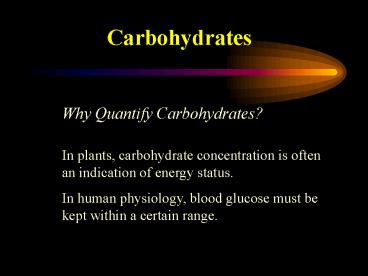Carbohydrates - PowerPoint PPT Presentation
1 / 17
Title:
Carbohydrates
Description:
In human physiology, blood glucose must be kept within a certain range. ... then add invertase to a separate aliquot to convert sucrose to glucose and fructose. ... – PowerPoint PPT presentation
Number of Views:65
Avg rating:3.0/5.0
Title: Carbohydrates
1
Carbohydrates
Why Quantify Carbohydrates?
In plants, carbohydrate concentration is often an
indication of energy status. In human physiology,
blood glucose must be kept within a certain range.
2
Carbohydrates - Sugar Forms
Sugars
Monomers Oligosaccharides Glucose Ma
ltose Raffinose Fructose Sucrose
Stachyose
Monomers are often called monosaccharides, Dimers
are often called disaccharides.
3
Carbohydrates - Sugar Alcohols
Mannitol Pinitol Inositol Galactinol
4
Carbohydrates - Polymer Forms
Polymers
Starch Fructans Amylose/Glycogen Inulins Amylo
pectin Levans Kesto-n-oses
5
Carbohydrate - Forms
Structural Polymers
Cellulose Hemicellulose Pectin
6
Carbohydrate Characteristics
For Analytical Purposes, An Important Question is
Does The Compound Have a Reducing End? Glucose
and Fructose have a free reducing end. Sucrose
and Starch do not.
7
Carbohydrate Analysis
How Does an Analysis Use This Difference? When
glucose or fructose have a free reducing end,
it will react with several different reagents.
The reaction is often linked to a chromophore
where glucose concentration can be determined
indirectly with a spectrophotometer.
8
Carbohydrate Analysis
Why Dont the Oligosaccharides React? For
sucrose, glucose and fructose are connected by a
covalent bond that ties up each of their reducing
ends. For amylose (starch), hundreds of glucose
units are bonded together but all of their
reducing ends (except for one) are unavailable.
Thus, a starch molecule may react but its
sensitivity is essentially zero.
9
Carbohydrate Mixtures
In A Leaf We Find A Mixture of Many Carbohydrates
Such As Glucose, Sucrose, and Starch. How Do We
Quantify Sucrose and Starch Without Interference
From Glucose?
10
Carbohydrate Extraction
Let us consider a leaf sample, where we wish to
quantify glucose, sucrose, and starch separately.
We can separate sugars from starch by using
ethanol as a solvent. Starch and proteins dont
dissolve in ethanol. Next, we need to separate
glucose from sucrose.
11
Separating GlucoseFrom Sucrose
Most soluble carbohydrate methods will detect
glucose but not sucrose. One can measure glucose
first then add invertase to a separate aliquot to
convert sucrose to glucose and fructose. Then,
one measures glucose again and by subtraction
calculates sucrose.
12
Separating GlucoseFrom Fructose
Many glucose procedures may also detect fructose.
However, by using specific enzymes to produce a
chromophore, one can prevent fructose from
interfering.
13
Solubilizing Starch
To solubilize starch, we can first take the
residue from the ethanol extract and boil it in
water or a basic NaOH solution. Heat and basic
conditions will destroy glucose.
14
Hydrolyzing Starch
To convert starch to glucose, we change the pH to
4.5, and then add amylase and/or
amyloglucosidase. After about 1 hour at 45ºC,
the starch is converted to glucose. Then,
glucose can be analyzed.
15
Glucose Kit
Principle Glucose ATP G-6-P
ADP G-6-P NADP 6-PG
NADPH NADPH Phenazine methosulfate
(PMS) NADP PMSH PMSH Iodonitrotetrazolium
chloride (INT) PMS INTH
Sigma Diagnostics
16
Enzyme Specificity
Hexokinase converts glucose to G-6-P but the
Sigma manual says fructose and mannose will also
be phosphorylated and thus, interfere.
Glucose-6-Phosphate Dehydrogenase is apparently
specific and requires G-6-P to convert NADP to
NADPH and
6-phosphogluconate.
17
Competing Enzymes
Any enzymes in the system have the potential to
affect the fate of glucose and thus, the
absorbance. Any compounds that cause NADP to be
reduced would cause interference.































